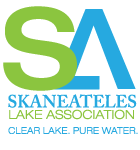ALERT: Harmful Algal Blooms (HABs) have been observed in the south eastern end of the lake. LEARN MORE
ALERT: Harmful Algal Blooms (HABs) have been observed in the south eastern end of the lake. LEARN MORE
Microcystin – a common cyanotoxin with known health effects to humans and animals. Lab analysis requires a turnaround time of up to a couple of days. A reading of above 10 parts per billion (ug/L) in open water or 20 ug/L near shore indicates a Confirmed bloom with High Toxins, according the WHO standards adopted by the DEC.
BG Chl a – Blue Green Chloraphyll a – used as a cheap and quick surrogate indicator due to a high correlation for the potential presence of a HAB. The presence of BG Chl a at a level of above 25 parts per billion (ug/L) is used to indicate a Confirmed bloom. Cyanotoxins may or may not be present but the potential for toxins necessitates naming a Confirmed Bloom.
Note: There are different standards used by the NYS DOH for pub lic beaches and drinking water.
Beaches are closed on sighting of a suspicious bloom with no sampling. Beaches are not reopened until the water has cleared for 24 hours and testing of microcystins comes back negative at a threshold the DOH defines as < 4ug/L based on USEPA Draft exposure standards, 2016.
Drinking water standards are tighter still with levels of <0.3 ug/L for children for over 10 days and 1.6 ug/L for adults for 10 days of exposure. Learn more in links below.
Results from Skaneateles Lake shoreline sampling efforts at the Skaneateles Country Club on 10/8 confirm the presence of a cyanobacteria HAB in Skaneateles Lake (Cayuga, Cortland, Onondaga Co.) based on blue-green chlorophyll a levels of 1573.29 µg/L (above the DEC Confirmed Bloom threshold of 25 µg/L) and a microscopic analysis of Microcystis. DEC has confirmed that bloom conditions have dissipated.
Toxin data are not yet available, but will be forwarded upon receipt if they indicate an elevated risk.
Exposure to any cyanobacteria HABs can cause health effects in people and animals when water with blooms is touched, swallowed, or when airborne droplets are inhaled. This is true regardless of toxin levels; some blue-green algae produce toxins, while others do not. Exposure to blooms and toxins can cause symptoms such as diarrhea, nausea or vomiting; skin, eye or throat irritation and allergic reactions or breathing difficulties. People and pets should avoid contact with blooms, and should rinse off with clean water if contact occurs. For more information go towww.health.ny.gov/harmfulalgae
Any questions or comments may be sent to HABsInfo@dec.ny.gov
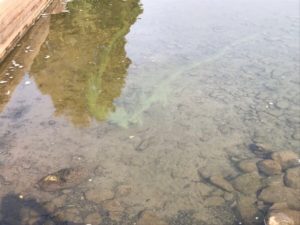
Results from Skaneateles Lake shoreline sampling efforts on 9/27 confirm the presence of a cyanobacteria HAB in Skaneateles Lake (Cayuga, Cortland, Onondaga Co.) based on blue-green chlorophyll a levels of 109.35 µg/L (above the DEC Confirmed Bloom threshold of 25 µg/L) and a microscopic analysis of Microcystis. The size of the bloom according to the sampler is small localized. The sample was collected from Zone 24 near the Country Club.For more information on the Zone locations go to:https://skaneateleslake.org/bloom-updates/ Toxin data will be forwarded upon receipt if they indicate an elevated risk. Exposure to any cyanobacteria HABs can cause health effects in people and animals when water with blooms is touched, swallowed, or when airborne droplets are inhaled. This is true regardless of toxin levels; some blue-green algae produce toxins, while others do not. Exposure to blooms and toxins can cause symptoms such as diarrhea, nausea or vomiting; skin, eye or throat irritation and allergic reactions or breathing difficulties. People and pets should avoid contact with blooms, and should rinse off with clean water if contact occurs. For more information go to www.health.ny.gov/harmfulalgae.
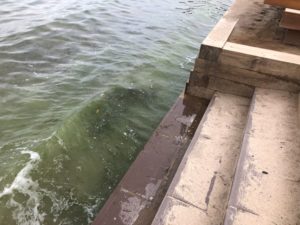
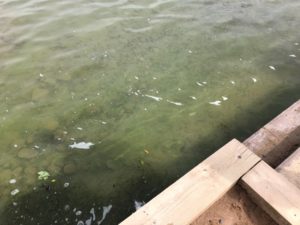
Results from CSLAP shoreline sampling efforts on 9/16 confirm the presence of a cyanobacteria HAB in Skaneateles Lake (Cayuga, Cortland, Onondaga Co.) based on blue-green chlorophyll a levels of 218.4 µg/L (above the DEC Confirmed Bloom threshold of 25 µg/L) and a microscopic analysis of Microcystis. The size of the bloom according to the sampler is not reported and the location of the sample was Zone 02. For more information on the Zone locations go to: https://skaneateleslake.
org/bloom-updates/. DEC has confirmed, based on recent surveillance, that bloom conditions have dissipated. Toxin data are not yet available, but will be forwarded upon receipt if they indicate an elevated risk.
Exposure to any cyanobacteria HABs can cause health effects in people and animals when water with blooms is touched, swallowed, or when airborne droplets are inhaled. This is true regardless of toxin levels; some blue-green algae produce toxins, while others do not. Exposure to blooms and toxins can cause symptoms such as diarrhea, nausea or vomiting; skin, eye or throat irritation and allergic reactions or breathing difficulties. People and pets should avoid contact with blooms, and should rinse off with clean water if contact occurs. For more information go to www.health.ny.gov/harmfulalgae
. Any questions or comments may be sent to HABsInfo@dec.ny.gov
Below are the results from samples collected by trained volunteers on Skaneateles Lake. The sampling confirmed the presence of cyanobacteria HABs in the locations listed below. The bloom status is compared to the DEC Confirmed Bloom threshold of 25 µg/L Bluegreen Chlorophyll. For more information on the Zone locations go to: https://skaneateleslake.org/bloom-updates/
| Date | Location | HABs Status | BG Chl a (µg/l) | Visual Analysis |
| 13-Sep | Zone 10 (Red Tail Lane) | Confirmed | 339 | Microcystis, Aphanizomenon |
| 13-Sep | Zone 24 (Skaneateles Country Club) | Confirmed | 441 | Microcystis |
Exposure to any cyanobacteria HABs can cause health effects in people and animals when water with blooms is touched, swallowed, or when airborne droplets are inhaled. This is true regardless of toxin levels; some blue-green algae produce toxins, while others do not. Exposure to blooms and toxins can cause symptoms such as diarrhea, nausea or vomiting; skin, eye or throat irritation and allergic reactions or breathing difficulties. People and pets should avoid contact with blooms, and should rinse off with clean water if contact occurs. For more information go to www.health.ny.gov/harmfulalgae.
Any questions or comments may be sent to HABsInfo@dec.ny.gov
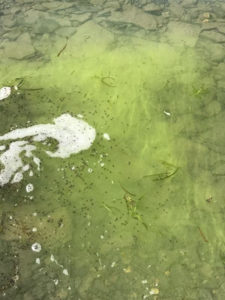
The toxin results from a shoreline sample collected by a Skaneateles Lake Association volunteer on 9/4 from Zone 3524 on Skaneateles Lake confirmed elevated toxin levels. A microcystin concentration of 470 µg/L is above the DEC Confirmed with High Toxins Bloom threshold of 20 µg/L for a shoreline sample. The size of the bloom according to the volunteer was small localized. For more information on the Zone locations go to:https://skaneateleslake.org/
The bloom in this location is reported to have dissipated already. There have been no additional HAB reports on Skaneateles since 9/5/18.
Exposure to any cyanobacteria HABs can cause health effects in people and animals when water with blooms is touched, swallowed, or when airborne droplets are inhaled. This is true regardless of toxin levels; some blue-green algae produce toxins, while others do not. Exposure to blooms and toxins can cause symptoms such as diarrhea, nausea or vomiting; skin, eye or throat irritation and allergic reactions or breathing difficulties. People and pets should avoid contact with blooms, and should rinse off with clean water if contact occurs. For more information go to www.health.ny.gov/harmfulalgae.
Any questions or comments may be sent to HABsInfo@dec.ny.gov
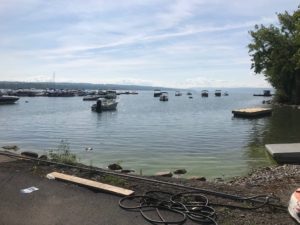
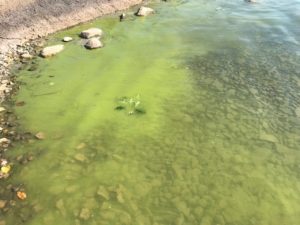
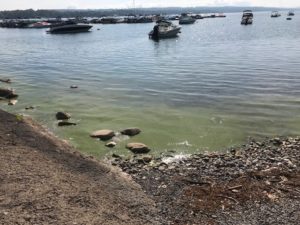
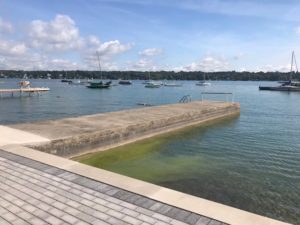
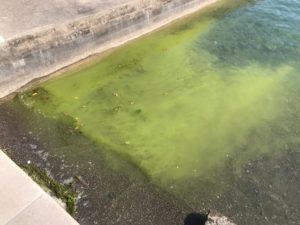
DEC results sent to HAB Program Participants:
Below are the results from samples collected by trained volunteers and City of Syracuse staff on SkaneatelesLake late last week and this week. The sampling confirmed the presence of cyanobacteria HABs in the locations listed below. The bloom status is compared to the DEC Confirmed Bloom threshold of 25 µg/L Bluegreen Chlorophyll and a Confirmed with High Toxin Bloom threshold of 20 µg/L microcystin.
The toxin results from a shoreline sample collected on 8/4 confirmed elevated toxin levels. A microcystin concentration of 176 µg/L is above the DEC Confirmed with High Toxins Bloom threshold of 20 µg/L for a shoreline sample.
Additional bloom reports received by DEC this morning (8/10) were not confirmed and appear to have dissipated quickly.
Samples for both raw and finished water were collected (8/9) and tested at the intakes for public drinking water serving the Village and Town of Skaneateles, the Village, and Town of Elbridge, the Village of Jordan, parts of the Town of Dewitt, and the City of Syracuse. The samples indicate no impact to drinking water quality for customers. In accordance with the City and County action plan, the city will continue with testing of raw and finished water. That plan also includes increasing chlorine levels in the intakes, an effective means of mitigating microcystin which already began earlier this week. For more information and results go to: www.ongov.net/health/bluegreenalgae.html.
*The update to today’s DEC Notification page represents the most recent sampling information.
Exposure to any cyanobacteria HABs can cause health effects in people and animals when water with blooms is touched, swallowed, or when airborne droplets are inhaled. This is true regardless of toxin levels; some blue-green algae produce toxins, while others do not. Exposure to blooms and toxins can cause symptoms such as diarrhea, nausea or vomiting; skin, eye or throat irritation and allergic reactions or breathing difficulties. People and pets should avoid contact with blooms, and should rinse off with clean water if contact occurs. For more information go to www.health.ny.gov/harmfulalgae.
| Location | Date | HABs Status | BG Chl a (µg/l) | Microcystin (µg/l) | Visual Analysis |
| Village Jetty Nearshore | 8/4/2018 | Confirmed with High Toxins | 723 | 176 | Microcystis |
| Bobbett Lane | 8/5/2018 | Confirmed | 87 | 16 | Microcystis |
| Widas | 8/5/2018 | Confirmed | 54 | 13 | Microcystis |
| jetty near shore | 8/6/2018 | No Bloom | 10 | 16 | Microcystis |
| Bathing Beach | 8/6/2018 | No Bloom | 4 | 0.6 | Microcystis |
| Mile Point Zone 24 | 8/7/2018 | Confirmed | 1574 | * | Microcystis |
| West shore, mid lake | 8/10/18 | Suspicious | N/A | N/A | N/A |
* Toxin result is not yet available; will be forwarded upon receipt if they indicate an elevated risk.
